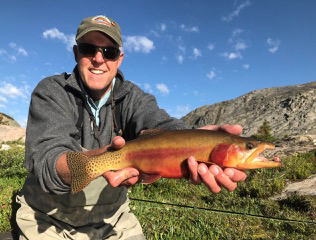 One look at a golden trout and you will be captured by its beauty. General Chuck Yeager caught golden trout—or should we say this colorful fish, native only to the high southern Sierra Nevada Mountains, caught him.
One look at a golden trout and you will be captured by its beauty. General Chuck Yeager caught golden trout—or should we say this colorful fish, native only to the high southern Sierra Nevada Mountains, caught him.
Like so many anglers from California and beyond, Yeager went to great lengths to fish for golden trout in the Sierras. They naturally occur in high mountain streams. As a younger man, Yeager was well acquainted with the state fish of California. In the early 1960s, the fabled pilot facilitated the stocking of golden trout in New Mexico, done at the behest of his commander General Irving “Branch” Twig. We have to take him on his word; Yeager confessed to the deed in his 1986, Yeager: an Autobiography.
It was an elaborate ordeal moving fish from California to New Mexico, involving aircraft and a truck with aerated tanks. But the trout apparently did not have the right stuff for life in the Southwest and did not persist.
However, they persist in their native California. Thanks to federal excise taxes paid by fishing tackle manufacturers through the Sport Fish Restoration Act (Dingell-Johnson), the gorgeous trout and those who fish for them are the beneficiaries of scientific management, monitoring, and research. The California Department of Fish and Wildlife (CDFW) performs the work through cost-share funded grants administered by the U.S. Fish and Wildlife Service’s Wildlife and Sport Fish Restoration program.
Golden trout in two streams have received much attention from CDFW. In recent years, biologists have assessed populations, collected trout tissues for genetic analysis, and built and monitored fish barriers.
Federal excise taxes funded the construction of concrete fish barriers at Schaeffer and Templeton Meadows on the South Fork Kern River. The barriers are essential to maintaining pure golden trout populations upstream; it keeps predatory nonnative brown trout at bay as well as rainbow and golden-rainbow trout hybrids away from the important conservation population. For a decade, digital cameras have remotely surveyed Schaefer and Templeton Meadow barriers for their efficiency at varying flow levels.
Cattle, which can trample trout habitat, were excluded by fence from South Fork Kern River reaches in the Monache Meadow Wildlife Area. Maintenance of the state wildlife area is funded via the Wildlife Restoration Act (Pittman-Robertson) and excise taxes on firearms, ammunition, and archery gear.
The CDFW also performs conservation work on another stream, Golden Trout Creek. Its headwaters are fed by lakes, which unfortunately harbored compromised hybrid populations of golden trout. Those fish were removed to protect the genetic integrity of golden trout below the lakes.
Biologists from the CDFW have monitored the fish in Golden Trout Creek and two of its small tributary streams, Left Stringer and Volcanic creeks, for more than a decade. The beautiful streams purl past malpais beneath an array of steep mountains that top out at 10,000 feet and higher. The trout in the two tributaries are genetically pure, but the smaller waters are periodically isolated from the fish in Golden Trout Creek in low-water periods. In 2016, biologists relocated 48 trout from Left Stringer and Volcanic creeks to Nimbus Fish Hatchery in the face of an impending drying of the streams. Winter 2016-17 proved fortuitous for snowfall and subsequent runoff and biologists returned 44 golden trout to their natal waters, only four fish having perished in 10 months. But the historic California drought continues, and CDFW remains vigilant.
Similar to the remote cameras on barriers on South Fork Kern River, biologist use digital camera technology to monitor the connectivity of those streams tributary to Golden Trout Creek. The technology is also used to assess angling pressure along portions of Volcanic Creek.
Angling for golden trout requires wearing off some boot tread. The saying goes that trout don’t live in ugly places and the natural range of the golden trout is breathtakingly beautiful. And the trout—well, they look like they’ve been fed a diet of gold nuggets. Considering all this, you might see why General Yeager kept going back to the high country to fish for golden trout well into the sunset of his life.
To learn more, visit Partner with a Payer.
-- Craig Springer
Springer is with the USFWS – Wildlife and Sport Fish Restoration


 Advertising
Advertising